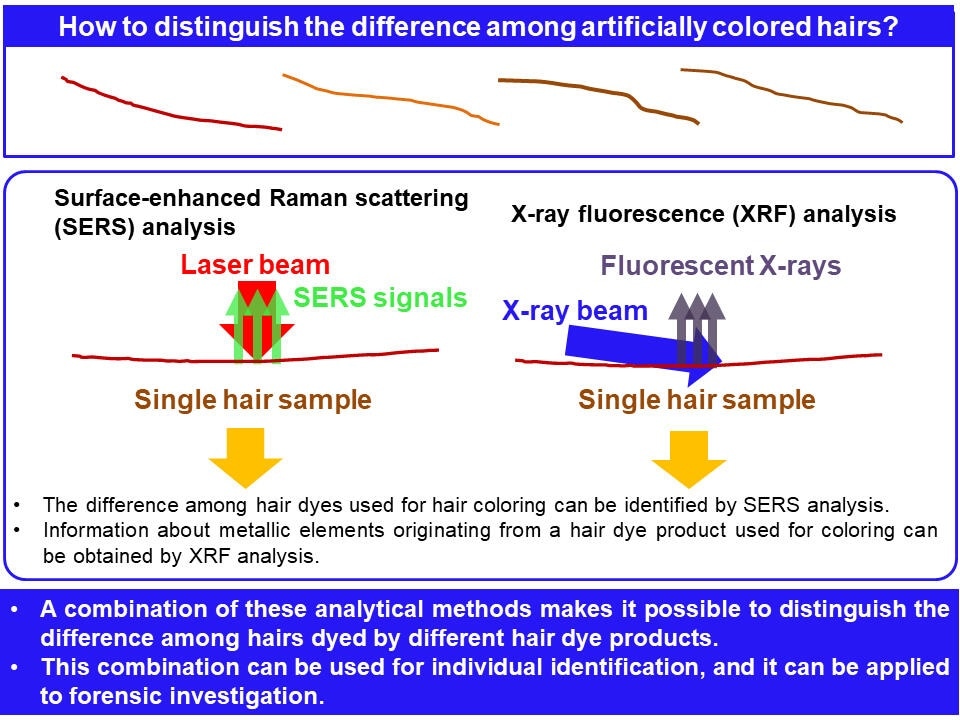During the investigations of crime scenes, even a single strand of human hair can make a significant difference in the evolution of a trial or case.

An overview of the analytical techniques used in this study, which together make it possible to distinguish between two single strands of colored hair. Image Credit: Kunimura from Tokyo University of Science.
In a majority of the cases, forensic scientists should search for clues that are concealed in tiny amounts of materials or substances detected at crime scenes. For example, if they find a fallen strand of hair with intact root cells, they can perform a DNA test to find out the identity of a perpetrator; but unfortunately, this rarely happens.
While other types of DNA analysis can be performed using the “mitochondrial DNA” integrated into the hair shaft itself, these tests are not enough to consistently identify an individual and often require more proof.
Perhaps, a bit of fashion consciousness could lead to a novel forensic method. In a new study published in the Analytical Sciences journal, investigators from the Tokyo University of Science in Japan have designed a novel approach for spotting criminals from just a single strand of hair, taking advantage of the fact that hair dyes are turning out to be progressively common.
In the new method, the researchers have to find out if two separate strands of hair belong to the same individual, depending on the composition of hair dye products detected on the criminal.
To achieve this, the team used two popular analytical techniques—X-ray fluorescence (XRF) analysis and surface-enhanced Raman spectroscopy (SERS) analysis.
The analytical technique, Raman spectroscopy, is based on the physical phenomenon of Raman scattering. This phenomenon models specific energetic interactions that take place when a collision occurs between photons and matter.
SERS is a unique type of Raman spectroscopy that offers a “structural fingerprint” of a material even when a minimal number of molecules exist in the sample of interest. Conversely, in XRF analysis, a material is first irradiated with X-rays and the energies of photons, which are re-emitted when the electrons in the sample exit the excited states, are subsequently examined. XRF analysis is particularly handy to find out which types of metallic elements exist in a material.
Using portable devices, the researchers performed XRF and SERS analyses to find out whether they can differentiate between single strands of hog hairs dyed with different kinds of products.
Shinsuke Kunimura, an Associate Professor who headed the research work, explained why both analytical techniques had to be used together.
SERS can easily detect the overall differences in composition between different types of hair dyes, such as permanent, semi-permanent, or natural dyes. However, it is not enough to distinguish between hair coloring products that contain or produce similar dyes. To do this, we also relied on XRF analysis, which can detect the presence of metallic elements used in the ingredients of hair dye products.”
Shinsuke Kunimura, Study Lead and Associate Professor, Tokyo University of Science
The researchers used both methods and easily differentiated between five different kinds of dyes used on individual strands of hog hair.
Since both analytical techniques used by the team are virtually non-destructive, the method recommended in this analysis could be used to rapidly examine the hairs detected in crime scenes on-site before sending them for DNA analysis.
Our approach provides supportive information for more reliably identifying whose hair was found in a crime scene. This could help us clarify if someone is a criminal, meaning that our methodology could greatly contribute to forensic investigations.”
Momona Horiguchi, Study First Author, Tokyo University of Science
On the whole, this study demonstrates how analytical tools that are generally used in materials science and chemistry can be creatively modified to suit many different areas, like forensic investigations. In the days to come, it is hoped that the new approach will deter criminals from escaping by a hair’s breadth.
Source:
Journal reference:
Horiguchi, M & Kunimura, S (2020) Surface-enhanced Raman Scattering and X-ray Fluorescence Analyses of a Single Hair Colored with a Hair Dye Product. Analytical Sciences. doi.org/10.2116/analsci.20P144.